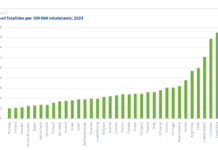Justice40 “benefits” could mean more emissions, worse health outcomes in disadvantaged communities
How can we ensure that investments in communities lead to safer, more convenient infrastructure for all?In President Biden’s first weeks in office, he established...
The half-promise of the Carbon Reduction Program
This post was written by Mollie Dalbey and Stephen Coleman Kenny, members of the Transportation for America policy team.
The Carbon Reduction Program (CRP), a...
Getting to equitable outcomes in the infrastructure law
Despite the rhetoric, the infrastructure law falls well short of truly addressing the decades of harm our transportation system has inflicted on marginalized communities,...
The infrastructure law is not climate legislation, but states could make it green
On Jan. 10, 2015, Dock Street in Annapolis, MD flooded after receiving over three quarters of an inch of rain in 24 hours. Flickr...
Mobility’s Future is Fossil Fuel-Free
The catastrophic weather events of the past year demand that we grapple with the realities of an increasingly unpredictable global climate brought on by...
Compact Electric Cities: The Only Way to 1.5°
To meet the goals of the Paris Climate Agreement and for a chance of limiting climate change to less than 1.5°C, neither vehicle electrification...
In Jakarta, New Study Finds Bus Electrification is Both Feasible and Urgent
The Government of Jakarta has committed to electrifying 100% of its Transjakarta bus fleets by 2030, which amounts to over 10,000 vehicles. Since 2020,...
Is the federal government squandering clean transit funds?
A new report shows splitting clean transit funds between zero-emission vs. low-emission is holding U.S. transit agencies back from cleaning up the bus fleet.
WASHINGTON—A...
In Jakarta, the Case for Bus Electrification Grows Stronger
The Government of Jakarta has committed to electrifying 100% of its Transjakarta bus fleets by 2030, which amounts to over 10,000 vehicles. Since 2020,...















